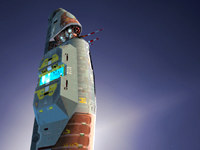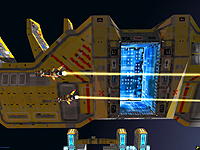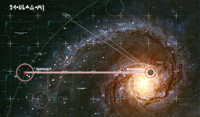Overview
Reviews & Awards
Buy
![]()
Fan Sites
Message Boards
Developer's Lounge
The Mothership
Mothership sections and systems
In such a huge vessel dedicated to so many tasks, it is necessary to devote entire areas towards fulfilling each part of the ship's mandate.
Navigation
The Mothership has two modes of travel. The first is based on conventional fusion drive technology, and is basically a series of large fusion reactors designed to vent high-energy plasma through an opening in a shaped magnetic bottle. They provide a slow but steady 2G acceleration at maximum output. Maneuvering jets are fed plasma from the main exhaust through a series of conduits, and this allows a portion of the main thrust to be diverted to maneuvering.
The full implications of the Mothership's hyperdrive is not completely understood, but it is the system that makes this voyage possible. Toward the lower aft portion of the ship lies the large shielded area containing the Hyperspace Module. This is a direct copy of the one found under the sands of Khar-Toba, but expanded 12-fold to accommodate a vessel of the Mothership's mass. Even though the effect has been tested extensively through ships fitted with test modules of various sizes, our control and understanding of the effect is somewhat limited. This has resulted in a need for massive energy to induce the wavefront, prohibiting its use on any vessel too small to carry at least three industrial fusion plants.
There is another drawback to our limited understanding of hyperspace. We can only induce a linear tunnel effect of massive proportions with relatively crude control of distance. The module is projected to have a range of 2500 light years for a single waveform event, and in order to trigger the drive we must charge the module with all the energy required for such a stunning distance. Should we wish to travel a more appropriate and cautious distance, we must crudely halt the wave effect by discharging the module's energy, and dropping back into normal space-time.
Fleet Command
As the project neared completion and the full size and complexity of the Mothership became clear, System Coherency specialists encountered a problem that seemed to defy solution. In even the most basic function simulations, there was so much data to be analyzed, so many responses per second required, that the projected bridge crew grew into the hundreds. As new command staff were added to the simulation, the hierarchy became unmanageable. It became apparent that in any sort of crisis, the Mothership would quickly suffer from communications paralysis. Computational experts tried, but no simulated intellect system they could devise could be trusted 100%, and the whole project faltered until a young neuronics expert stepped forward with a desperate plan. Karan Sjet was working on experimental biological circuits that would mimic brain functions. When she heard that an information bottleneck was facing the crew of the Mothership, she realized her research could be put to another purpose.
Neuronicist Sjet suggested using an existing brain — her own — to bridge the gap between living nerve branches and the Mothership's data shunts.
As Fleet Command, she is capable of handling hundreds of alerts and updates per second, while analyzing what tasks can be handled automatically and which situations need to be brought to the attention of the crew. Should the ship come under fire, she will instantly analyze systems across the entire length of the ship and monitor everything from construction to research progress. Fleet command observes the status of all vessels and updates their positions. Research reports are also processed through her central core, along with information on construction projects.
Fleet Intelligence
It is the job of Fleet Intelligence to analyze incoming data from probes, observation equipment and sensors. Centered just below the main bridge is a large spherical chamber containing work/com stations, with data shunts centered around a full holographic projection pit. When the Mothership is underway, this pit will be manned permanently by shift teams composed of the best scientists, diplomats, linguists and tactical officers, all specially selected not only for their knowledge, but their adaptability. Fleet Intelligence has access to not only the Mothership's sensor arrays but also to the Fleet Archives as well. Whatever the Mothership should encounter in deep space, Fleet Intelligence will interpret the data and give as accurate an analysis as the situation permits, offering tentative conclusions and tactical recommendations.
Cryogenics
The major stumbling block for the plans to start a new colony was life support. The resources needed to keep 5,000,000 people alive for years in deep space are simply impossible to store and transport; the Mothership would have to be so huge that no number of fusion plants could move it. To solve the problems of a long spaceflight, our life-scientists turned to cryogenic suspension. With the technology tested and perfected, engineers began filling the cryonic hold with the 500,000 pods that would be required for the voyage.
Volunteers have chosen to surrender as much as 12 years of their lives before the voyage even starts in order to be processed for cold sleep. First, they are prepared and placed in their cryonic pods, where they are slow frozen over a period of two weeks. The pods are then stored in holding areas deep under the surface of Kharak until 100 of them are ready to be placed on a rack module and boosted into space together aboard the heavy lifter units. These racks are then taken to a stable gravitational point called T2, where they are stored, requiring minimal power, until the Mothership is ready to take them onboard.
The vast hall aboard the Mothership containing our people is in the most protected and armored area of the vessel. The cryonic vault stretches for three kilometers and is almost a kilometer across. All that is required for life support is a constant supply of power to the freezing units. A deviation of even a single degree can be fatal to the occupants if it occurs outside the intricate revivification procedure. In light of this, even though the five million pods draw their power from the main reactor core, some auxiliary fusion pylons are set into the vault walls, each one capable of handling the power demands of the vault by itself. Boarding and cryogenic placement has been occurring on schedule for the past decade, and should be completed shortly before the Mothership is scheduled to leave the Scaffold.
Mission
 In the first triad of 1159, a final plan was accepted for the vessel that would follow the path indicated by the Guidestone. What had delayed the project for so long was simply that no one, neither astronomers nor religious leaders, could say for certain what had driven us to Kharak, and so none could say what an expedition would encounter. It was finally decided to build a vessel that was capable of doing everything, including establishing a new colony deep coreward. Known simply as the Mothership, this vessel would be part carrier, part survey ship, part factory complex and, most importantly of all, the temporary home for millions of our people frozen in cryogenic sleep. It would have to be able to deal with the great unknown reaches of the galaxy, and whatever discoveries or threats they would contain. It would be the greatest construction project in our history, driven by the disturbing thought that whatever had brought us here had obviously been too much for us at the height of our technology. Ministers from every clan abandoned their cloistered, competitive policies and pooled their every resource to develop stratagems and designs, and then allocated them to the various industrial hubs throughout the polar zones. In the meantime, clans that had been trailing the cutting edge in technology and production turned their efforts completely over to agricultural work, feeding those clans who had ceased to feed themselves.
In the first triad of 1159, a final plan was accepted for the vessel that would follow the path indicated by the Guidestone. What had delayed the project for so long was simply that no one, neither astronomers nor religious leaders, could say for certain what had driven us to Kharak, and so none could say what an expedition would encounter. It was finally decided to build a vessel that was capable of doing everything, including establishing a new colony deep coreward. Known simply as the Mothership, this vessel would be part carrier, part survey ship, part factory complex and, most importantly of all, the temporary home for millions of our people frozen in cryogenic sleep. It would have to be able to deal with the great unknown reaches of the galaxy, and whatever discoveries or threats they would contain. It would be the greatest construction project in our history, driven by the disturbing thought that whatever had brought us here had obviously been too much for us at the height of our technology. Ministers from every clan abandoned their cloistered, competitive policies and pooled their every resource to develop stratagems and designs, and then allocated them to the various industrial hubs throughout the polar zones. In the meantime, clans that had been trailing the cutting edge in technology and production turned their efforts completely over to agricultural work, feeding those clans who had ceased to feed themselves.
Fleet Foundry
The Mothership is designed to be a mobile construction yard on par with the original orbital facilities that created the mega-vessel in the first place. The automated manufacturing bay is capable of high-speed production of vessels from tiny Scouts to larger ships that are yet to be designed. Various parallel production tracks allow for dozens of larger components to be cast and assembled at the same time, thus radically reducing the time needed to build larger vessels. Ships components are based on modular technologies, many of the same ones being used across various hull designs, thus saving time and allowing for faster simultaneous construction. The foundry floor is capable of using multiple construction tracks to simultaneously build a fleet of scouts, assemble a squadron of corvettes, and create enough ordinance for both sets of new ships. A large hangar provides docking sleeves for a huge array of vessels to be serviced — or the same sleeves can simply be used as berths should the Mothership need to enter hyperspace with a large fleet of auxiliary ships.
 None of this would be possible without the immense quantity of raw materials brought in by the resource-gathering vessels. Built around the model of the original cutting ships, which were used to break down raw materials for the initial construction of the Scaffold and the Mothership, the resource-gatherers are designed to reduce and scoop up a variety of space material, ranging from solid planetoids to gas nebulae. The gatherers then return to the Mothership and transfer the contents of their holds for processing through a Phased Disassembler Array. While this PDA is smaller and quite a bit more efficient than the orbital array used to supply the Scaffold, it works on the identical principal of arrayed fusion torches. It will reduce any material to its component elements, while a Magneto-Hydrodynamic Shunt Field sorts the vaporized elements according to atomic weight and carries them to the storage shells. The massive honeycomb of storage shells (almost three cubic kilometers of storage space) lies just under the surface of 65 percent of the Mothership's hull. This allows for quick access and venting in the event of a jam or storage-cell rupture, as well as providing a final layer of armor, in case the ship suffers from a catastrophic impact or weapon strike.
None of this would be possible without the immense quantity of raw materials brought in by the resource-gathering vessels. Built around the model of the original cutting ships, which were used to break down raw materials for the initial construction of the Scaffold and the Mothership, the resource-gatherers are designed to reduce and scoop up a variety of space material, ranging from solid planetoids to gas nebulae. The gatherers then return to the Mothership and transfer the contents of their holds for processing through a Phased Disassembler Array. While this PDA is smaller and quite a bit more efficient than the orbital array used to supply the Scaffold, it works on the identical principal of arrayed fusion torches. It will reduce any material to its component elements, while a Magneto-Hydrodynamic Shunt Field sorts the vaporized elements according to atomic weight and carries them to the storage shells. The massive honeycomb of storage shells (almost three cubic kilometers of storage space) lies just under the surface of 65 percent of the Mothership's hull. This allows for quick access and venting in the event of a jam or storage-cell rupture, as well as providing a final layer of armor, in case the ship suffers from a catastrophic impact or weapon strike.
 The mission facing the crew of the Mothership is profound; it is nothing less than the quest for the origins of an entire people. Our mission is now irrevocable. It has become clear through the past 120 years of driven industrial and technological expansion that Kharak can no longer sustain us. While always harsh and unforgiving, our technological development has stripped the planet of what few vital resources it contained, and the narrow bands of temperate climate at the poles have been slowly shrinking. In order to survive as a people we must leave Kharak.
The mission facing the crew of the Mothership is profound; it is nothing less than the quest for the origins of an entire people. Our mission is now irrevocable. It has become clear through the past 120 years of driven industrial and technological expansion that Kharak can no longer sustain us. While always harsh and unforgiving, our technological development has stripped the planet of what few vital resources it contained, and the narrow bands of temperate climate at the poles have been slowly shrinking. In order to survive as a people we must leave Kharak.
Homeworld: Synopsis
The discovery of our origins
The Mothership
The location of the Homeworld
Homeworld / Story